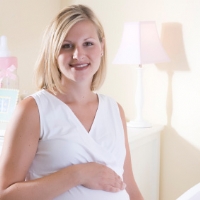Greening Your Baby's Nursery
By: Pamela Brill
You did everything to ensure a healthy pregnancy: you ate right, exercised and got more sleep than you have had in years. It's only natural that you'd want to create an equally healthy environment for your baby's first home.
While there are tremendous benefits to having a green nursery, the most important reason is your ability to reduce your child's exposure to toxic chemicals in the atmosphere. "Studies show that newborns will sleep 16-18 hours per day, so it is crucial to control the environment they are exposed to," says Sarah Gary of Sarah Ann Designs (sarahanndesigns.com).
"Babies have sensitive, often under-developed immune systems which can be particularly susceptible," adds Mary Bauer, president of Bratt Décor and a celebrity nursery designer. "Chemicals and toxins can be absorbed through the skin and inhaled, so keeping these substances to a minimum and out of baby's reach is important."
While creating a green nursery involves special considerations, it doesn't have to cost a lot of "green." Our experts show you what to look for while shopping and designing a healthy habitat for your precious bundle of joy.
Deciphering Label Language
When shopping for eco-friendly paints and other décor elements, nursery design specialists advise looking for labels and product packaging touting non-toxic substances and low VOCs (Volatile Organic Compounds). "These items will be free from dangerous pesticides, chemical dyes and bleaches and should be allergen-free," says Gary. While paints are no longer manufactured with lead, parents may still wish to have a professional check for lead traces in refurbished or older items. Gary also suggests visiting greenguard.org to determine which building materials, interior furnishings and cleaning products are safe to use.
Sometimes, the old adage, 'you get what you pay for,' rings true, especially when it comes to nursery design, says Kristin Hannah, owner of virtualinteriordesigners.com. "Less expensive, mass-produced items from overseas are typically more risky," she cautions. "Paints advertised as low VOC, organic cotton and natural fibers will help keep you on track."
A Safer, Softer Side
On the surface, most baby bedding may feel soft and cuddly, but in reality, not all crib linens are created equal. According to Hannah, blended fabrics or heavy printed and dyed fabrics have the potential of "off-gassing VOCs," meaning transferring chemicals right onto skin. Instead, look for organic bedding, namely organic cotton, that doesn't incorporate any toxic chemicals.
The same holds true for mattresses, many of which are filled with foams that contain chemical additives. "Standard mattresses are treated with polybrominated diphenyl ethers (PBDCEs), a chemical that accumulates in our bodies and have been shown to affect the endocrine and nervous system," notes Gary. Instead, opt for green mattress options made with organic cotton or natural wool.
Greener Furnishings
New safety regulations help to ensure that more environmentally-friendly options for cribs, changing tables and rockers are available. "Many companies claim to be green, but offer no data to support their claims," says Bauer. Do your homework and be on the lookout for a P2 label on products containing MDF (Medium Density Fiberboard), which indicates that they meet the lowest governmental standard on chemical emissions.
On a less technical note, Gary advises investing in product that grows with your child--"it will not only save money in the future, but will cut back on waste in the environment"--and to keep nursery design minimal. "Chemicals attach to dust particles and to upholstered furniture, so it is best to keep furniture in basic, sustainable, naturally-stained woods," she says, adding that plastics are made from petroleum and typically end up in landfills.
Don't Break the Bank
Buying organic is often associated with a hefty pricetag, but this doesn't have to be the case for your baby's nursery. Hannah suggests buying close to home by working with local suppliers to help you find deals. "Once you are comfortable with a manufacturer and know the products you are looking for, turn to the Internet and shop for closeouts and discontinued items," she offers.
Also realize that you can do more with less. "Instead of a five-piece nursery set, buy less, but better: a crib with an organic mattress and a dresser that doubles as changer," suggests Bauer. For a personal touch, she adds, "do a fabulous wall color that adds serious design appeal in a water-based paint."
"And, have fun," concludes Bauer. "Fun is free."
